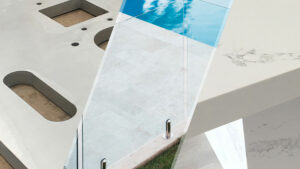Waterjet processes are commonly deployed in the marine industry today. The marine industry is one of the most innovative sectors globally. It works on the toughest materials with the most innovative technologies. Waterjet turns out to be a great solution for the hardest requirements of the sector.
This article will explore the application of waterjet cutting for the marine sector.
Waterjet Cutting
Waterjet cutting uses the extreme force of high-pressure water for cutting materials. Cutting is accomplished by eroding the particles of the workpiece. Waterjet cutting applies to a wide variety of materials like metals, non-metals, composites, paper, alloys, and more.
Cutting hard materials with a pure water jet is not fast enough. Therefore, abrasive materials are added to the water stream to speed up the process. The resulting method is called abrasive waterjet machining. Waterjet cutting is used in a variety of industries like the aerospace industry, defense industry, beverage industries, automotive industry, medical industry, etc.
What Marine Industry Materials Can Be Cut By a Waterjet?
Waterjet machines can virtually cut any type of material except diamonds. Therefore, it can achieve great results for all materials in the marine sector. The commonly encountered materials in the marine sector are:
Aluminum
Aluminum is the most used material not only in the marine industry but also in every other sector. Aluminum is used to craft large parts in the marine sector. Waterjet-cut aluminum makes deckhouses, hulls, ladders, railings, doors, window frames, and many other components.
Steel
Steel has exceptionally high strength and durability. This is why it is extensively used in marine applications. There are many grades of steel used for these purposes. All these grades can be easily cut with a waterjet cutter. In fact, water jet machining services can cut steel blocks 12 inches thick.
Stainless Steel
Stainless steel is preferred for many marine applications due to its corrosion resistance. Stainless steel also has good machinability so that the parts can be created cheaply. Waterjet cuts steel with a smooth edge for making fittings in ships and boating applications.
Titanium
Titanium is one of the strongest metals out there. It can resist corrosion even in extreme conditions of seawater. Deep sea equipment is encased in titanium shells for protection. These shells are made with waterjet cutting. Waterjet cutting can also make other titanium parts for seawater applications.
Alloys
The marine industry constantly uses alloys of copper-nickel, bronze, gunmetals, aluminum bronze, brass, silicon bronze, etc. The alloys combine properties like high physical strength, corrosion resistance, flexibility, and durability. These alloys often have poor machinability. Waterjet turns out to be a great way to cut these alloys.
Wood
Marine wood makes outdoor parts, stairs, furniture, support pillars, and many other components. Waterjet cuts multiple sheets of thick wood panels simultaneously. Unlike other cutting methods, using waterjet on wood doesn’t generate sawdust in the workplace.
Plastic
Plastics are used to make pipes, shafts, bearings, interior components, and many other things. Plastics are sensitive to heat. Therefore, conventional cutting processes can often cause thermal deformations in the material. However, waterjet cutting of plastic has no adverse effects.
Rubber
Rubber is used in marine applications for making fenders, bumpers, seals, and airtight containers. Rubber faces thermal deformations with hot-cutting processes similar to plastics. Therefore, water jet machining solutions are preferrable for marine rubber cutting.
Foam
Marine-grade foam is a versatile material. It replaces wood in many shipbuilding applications. It makes hulls, bulkheads, furniture, and interior parts. Foam cutting can be done with a pure waterjet cutter without adding abrasives.
Fabrics
Fabrics are mainly used for ship interiors and sails in the case of sailboats. Fabric cutting can also be done with pure waterjet without using an abrasive. This makes it a very cheap and fast process. Additionally, fabric cut with waterjet has no burn marks, unlike the laser cutting service. This increases its appeal in interior applications.
Polyethylene
Polyethylene is a helpful material in the marine sector due to its waterproof and transparent nature. As such, it is used for making a protective box for electrical fittings. It also makes cable monitoring boxes, underwater visit boxes, and counter boxes.
Marine Applications of Water Jet Cutting
Waterjet has a wide range of applications in the marine sector. Some common applications of this technology are:
Marine Exteriors
Waterjet technology makes several parts for the outer body of ships, boats, yachts, and other marine vehicles. These parts include:
- Frames: Entire frame structures can be cut with a waterjet. Common materials include metals and wood.
- Door Panels: Waterjet cutters can cut door panels in a single pass. In fact, waterjet cut door panels are used in a variety of industries in addition to marine.
- Windscreen: Windows and windscreen are made using waterjet cutting technology. A common example is the windscreen seen on a yacht frame.
Marine Interiors
Waterjet cutting is preferred for interiors due to its high precision and no visible marks after cutting. Some of the interior parts that it creates are:
- Carpets: Carpets in ships and yachts are cut with a waterjet cutter.
- Seats: Seats are made with waterjet cut foams, leathers, and other textiles
- Dashboard: Dashboards are made with waterjet-cut plastics and composites
Construction
Waterjet cuts thick, hard materials for marine construction elements like:
- Support pillars
- Columns
- Hulls
- Deck
- Deckhouse
Miscellaneous Marine Parts
Many other components in marine applications are made using a water jet. These components are:
- O-rings
- Gasket cutting kits
- Flanges
- Brackets
- Clutch Plates
- Moldings
- Propeller
- Rudder
- Bow
- Keel
Advantages of Waterjet Cutting in the Marine Industry
Due to its unmatchable benefits, waterjet cutting is the preferred choice in various industries. Some of these benefits for the marine industry are:
- No Heat-affected Zones: Waterjet is a cold-cutting method. Therefore, there is no thermal deformation or burn marks on the material.
- Preserving Material Integrity: Thermal deformations alter the physical properties of materials. Waterjet cutting preserves these properties. This is essential in marine applications where accidents must be avoided at all costs.
- Speed: Waterjet cutting is a fast process. Additionally, it cuts multiple layers of material simultaneously. This leads to fast cutting.
- Accuracy: There is extreme precision involved in waterjet cutting. It can have tolerances as low as +/- 0.001″.
- Convenience: Waterjet can cut thick metal sheets with ease. This provides the convenience of moving large parts. Large parts can be cut into smaller parts and then assembled.
- Versatile: Waterjet cutters can work on a wide variety of materials. Therefore, a single machine can do multiple jobs.
Where to Find a CNC Waterjet Cutting Machine?
Techni Waterjet is the leading brand in the waterjet industry globally. Many prominent brands of all sectors use these machines in their assembly line. Techni Waterjet has a range of CNC waterjet cutting machines at different price points and with different features. All machines come with embedded software that can control the cutting process with the click of a button. Techni Waterjet is a top global supplier, so all spare machine replacement products are available promptly.
Conclusion
Marine industry professionals are switching to waterjet cutting due to its remarkable results. Quality waterjet solutions not only ease manufacturing, they also lead to complete customer satisfaction. Get in touch with Techni Waterjet to learn which waterjet machine will fit your requirements perfectly!





